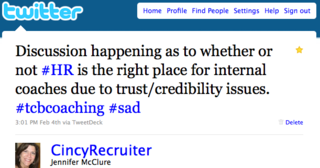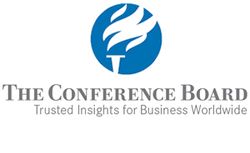At The Conference Board’s Executive Coaching Conference
that I recently attended, we spent some time in one of the sessions discussing concerns with HR pros being designated or trained as
internal coaches in organizations due to trust and credibility issues. (Note: attendees at the conference were primarily external coaches and OD professionals.)
Here’s a tweet I sent out during the discussion:
I guess the discussion made me a bit #sad because as a former Human Resources pro myself, I felt like I was effective as an internal “coach”. Whether working with an employee as part of their career development process or providing support to some making it through performance improvement plans, I worked hard to balance their need for confidentiality in the process with my responsibilities to the organization. I took pride in being someone that employees at all levels could talk to and one CEO even referred to me as his Consigliere – which considering some of the bullets I took for him, was kind of fitting.
But I do recall a conversation I had one day with an employee who was experiencing some issues at work. When I offered to listen and provide support, she said “Unfortunately, I can’t talk to you about this. It’s not that I don’t trust you personally. It’s the chair that you sit in. You have the authority to fire me. And I can’t risk that.”
After she left my office, I thought about what she’d said. I wanted to be offended. But I kinda understood where she was coming from. While it was frustrating that she wouldn’t allow me to try to help out just because of my position in the organization, I also knew that sometimes it was part of my role to be involved in making decisions about her career. So sharing a weakness or performance problem with someone who has that type of influence could be perceived as a risk.
Fast forward to today, where I work with clients as an external Executive Coach… The feedback I’ve received from clients is that one of the most helpful aspects of the coaching process is the opportunity to speak confidentially with someone outside of the organization who can listen, support, challenge and guide them. I’ve listened as senior level clients have shared with me a variety of potentially career damaging things – being afraid of making decisions, that they’re intimidated by a peer or they’re unhappy in their jobs. We’ve been able to work through and resolve those issues, but I’ve often wondered if it would be a challenge for me as an internal coach to have access to that same information.
HR often seems to get thrown under the bus in regards to confidentiality and credibility issues (if you’re the one causing that to happen, then please STOP), but I don’t agree that credibility/trust of internal coaches is an “HR” issue. I think it’s more about the perceived confidentiality that an external coach can provide – no matter how good an internal coach may be.
I think it’s hard for employees not to feel at risk when sharing information with people in a position to influence their careers.
What do you think? Can HR pros serve as effective coaches inside their organizations? Do external coaches have an advantage over internals?
The conversation at the conference has caused me to wonder if maybe the employee who was preoccupied with where I parked my derriere each day was on to something…



